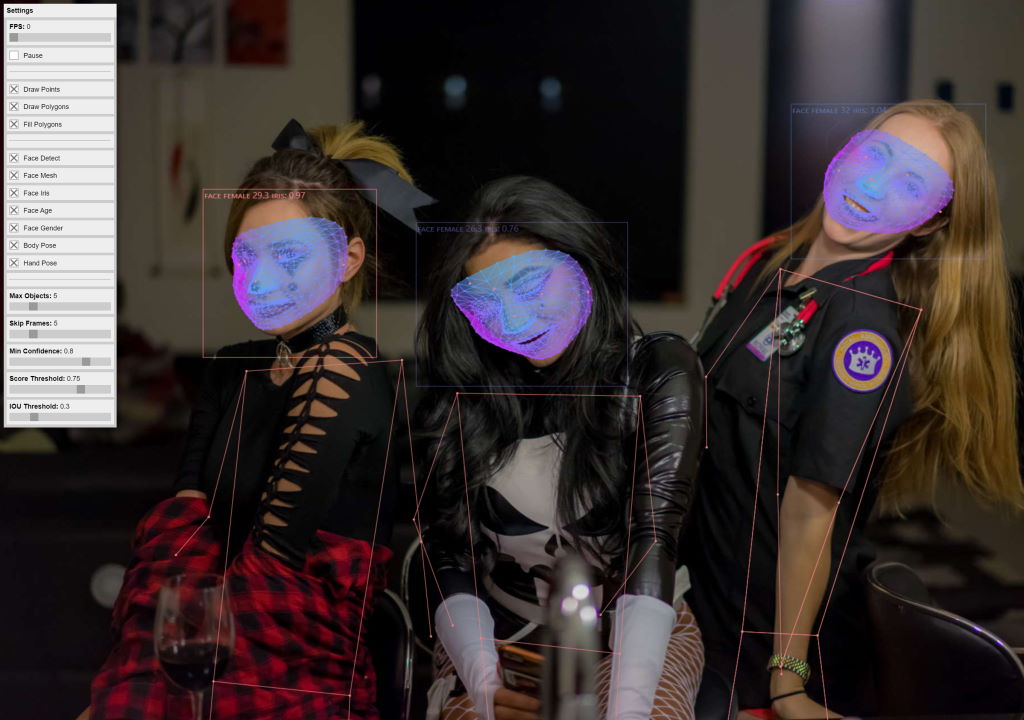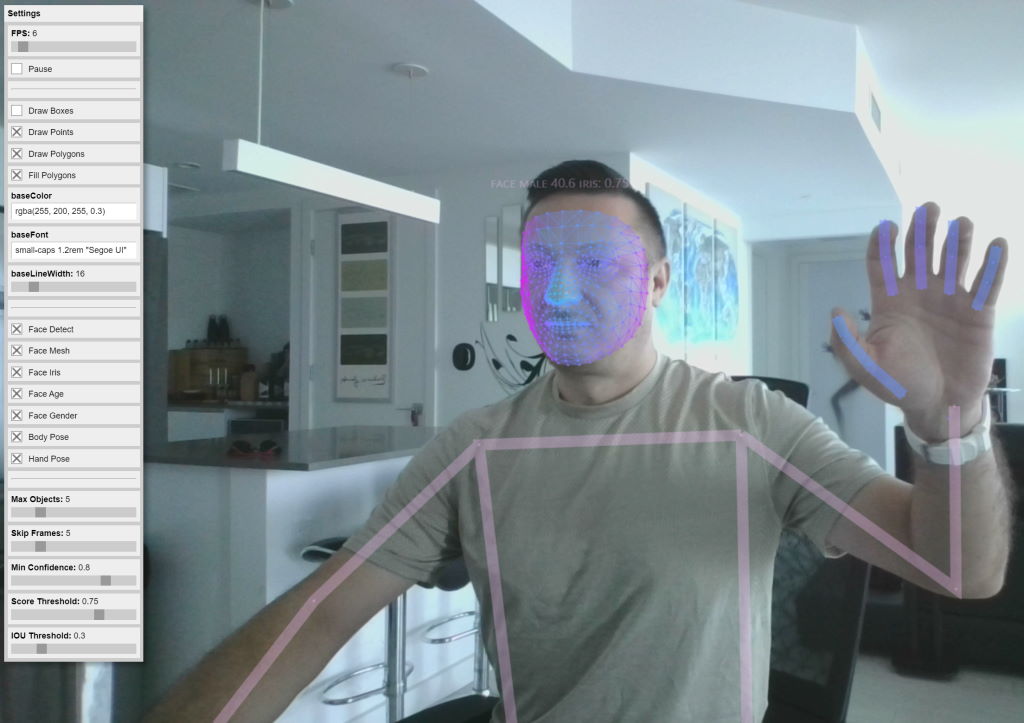|
|
||
|---|---|---|
| demo | ||
| dist | ||
| models | ||
| src | ||
| .eslintrc.json | ||
| .gitignore | ||
| LICENSE | ||
| README.md | ||
| package-lock.json | ||
| package.json | ||
README.md
Human: 3D Face Detection, Body Pose, Hand & Finger Tracking, Iris Tracking, Age & Gender Prediction & Emotion Prediction
Compatible with Browser, WebWorker and NodeJS execution!
This is a pre-release project, see issues for list of known limitations
Suggestions are welcome!
Installation
Important
The packaged (IIFE and ESM) version of Human includes TensorFlow/JS (TFJS) 2.6.0 library which can be accessed via human.tf
You should NOT manually load another instance of tfjs, but if you do, be aware of possible version conflicts
There are multiple ways to use Human library, pick one that suits you:
1. IIFE script
Simplest way for usage within Browser
Simply download dist/human.js, include it in your HTML file & it's ready to use.
<script src="dist/human.js"><script>
IIFE script auto-registers global namespace human within global Window object
This way you can also use Human library within embbedded <script> tag within your html page for all-in-one approach
IIFE script is distributed in minified form with attached sourcemap
2. ESM module
Recommended for usage within Browser
2.1 With Bundler
If you're using bundler (such as rollup, webpack, esbuild) to package your client application, you can import ESM version of Human library which supports full tree shaking
import human from '@vladmandic/human'; // points to @vladmandic/human/dist/human.esm.js
Or if you prefer to package your version of tfjs, you can use nobundle version
import tf from '@tensorflow/tfjs'
import human from '@vladmandic/human/dist/human.nobundle.js'; // same functionality as default import, but without tfjs bundled
2.2 Using Script Module
You could use same syntax within your main JS file if it's imported with <script type="module">
<script src="./index.js" type="module">
and then in your index.js
import human from 'dist/human.esm.js';
ESM script is distributed in minified form with attached sourcemap
3. NPM module
Recommended for NodeJS projects that will execute in the backend
Entry point is bundle in CJS format dist/human.node.js
You also need to install and include tfjs-node or tfjs-node-gpu in your project so it can register an optimized backend
Install with:
npm install @tensorflow/tfjs-node @vladmandic/human
And then use with:
const tf = require('@tensorflow/tfjs-node');
const human = require('@vladmandic/human'); // points to @vladmandic/human/dist/human.node.js
Since NodeJS projects load weights from local filesystem instead of using http calls, you must modify default configuration to include correct paths with file:// prefix
For example:
const config = {
body: { enabled: true, modelPath: 'file://models/posenet/model.json' },
}
Note that when using Human in NodeJS, you must load and parse the image before you pass it for detection
For example:
const buffer = fs.readFileSync(input);
const image = tf.node.decodeImage(buffer);
const result = human.detect(image, config);
image.dispose();
Weights
Pretrained model weights are includes in ./models
Default configuration uses relative paths to you entry script pointing to ../models
If your application resides in a different folder, modify modelPath property in configuration of each module
Demo
Demos are included in /demo:
Browser:
demo-esm: Demo using Browser with ESM moduledemo-iife: Demo using Browser with IIFE moduledemo-webworker: Demo using Browser with ESM module and Web Workers All three following demos are identical, they just illustrate different ways to load and work withHumanlibrary:
NodeJS:
demo-node: Demo using NodeJS with CJS module
This is a very simple demo as althoughtHumanlibrary is compatible with NodeJS execution
and is able to load images and models from local filesystem,
Usage
Human library does not require special initialization.
All configuration is done in a single JSON object and all model weights will be dynamically loaded upon their first usage(and only then, Human will not load weights that it doesn't need according to configuration).
There is only ONE method you need:
import * as tf from '@tensorflow/tfjs';
import human from '@vladmandic/human';
// 'image': can be of any type of an image object: HTMLImage, HTMLVideo, HTMLMedia, Canvas, Tensor4D
// 'options': optional parameter used to override any options present in default configuration
const result = await human.detect(image, options?)
or if you want to use promises
human.detect(image, options?).then((result) => {
// your code
})
Additionally, Human library exposes several classes:
human.defaults // default configuration object
human.models // dynamically maintained object of any loaded models
human.tf // instance of tfjs used by human
Configuration
Below is output of human.defaults object
Any property can be overriden by passing user object during human.detect()
Note that user object and default configuration are merged using deep-merge, so you do not need to redefine entire configuration
human.defaults = {
face: {
enabled: true,
detector: {
modelPath: '../models/blazeface/model.json',
maxFaces: 10,
skipFrames: 10,
minConfidence: 0.8,
iouThreshold: 0.3,
scoreThreshold: 0.75,
},
mesh: {
enabled: true,
modelPath: '../models/facemesh/model.json',
},
iris: {
enabled: true,
modelPath: '../models/iris/model.json',
},
age: {
enabled: true,
modelPath: '../models/ssrnet-imdb-age/model.json',
skipFrames: 10,
},
gender: {
enabled: true,
modelPath: '../models/ssrnet-imdb-gender/model.json',
},
emotion: {
enabled: true,
minConfidence: 0.5,
skipFrames: 10,
useGrayscale: true,
modelPath: '../models/emotion/model.json',
},
},
body: {
enabled: true,
modelPath: '../models/posenet/model.json',
maxDetections: 5,
scoreThreshold: 0.75,
nmsRadius: 20,
},
hand: {
enabled: true,
skipFrames: 10,
minConfidence: 0.8,
iouThreshold: 0.3,
scoreThreshold: 0.75,
detector: {
anchors: '../models/handdetect/anchors.json',
modelPath: '../models/handdetect/model.json',
},
skeleton: {
modelPath: '../models/handskeleton/model.json',
},
},
};
Where:
enabled: controls if specified modul is enabled (note: module is not loaded until it is required)modelPath: path to specific pre-trained model weightsmaxFaces,maxDetections: how many faces or people are we trying to analyze. limiting number in busy scenes will result in higher performanceskipFrames: how many frames to skip before re-running bounding box detection (e.g., face position does not move fast within a video, so it's ok to use previously detected face position and just run face geometry analysis)minConfidence: threshold for discarding a predictioniouThreshold: threshold for deciding whether boxes overlap too much in non-maximum suppressionscoreThreshold: threshold for deciding when to remove boxes based on score in non-maximum suppressionuseGrayscale: convert color input to grayscale before processing or use single channels when color input is not supportednmsRadius: radius for deciding points are too close in non-maximum suppression
Outputs
Result of humand.detect() is a single object that includes data for all enabled modules and all detected objects:
result = {
face: // <array of detected objects>
[
{
confidence, // <number>
box, // <array [x, y, width, height]>
mesh, // <array of 3D points [x, y, z]> 468 base points & 10 iris points
annotations, // <list of object { landmark: array of points }> 32 base annotated landmarks & 2 iris annotations
iris, // <number> relative distance of iris to camera, multiple by focal lenght to get actual distance
age, // <number> estimated age
gender, // <string> 'male', 'female'
}
],
body: // <array of detected objects>
[
{
score, // <number>,
keypoints, // <array of 2D landmarks [ score, landmark, position [x, y] ]> 17 annotated landmarks
}
],
hand: // <array of detected objects>
[
{
confidence, // <number>,
box, // <array [x, y, width, height]>,
landmarks, // <array of 3D points [x, y,z]> 21 points
annotations, // <array of 3D landmarks [ landmark: <array of points> ]> 5 annotated landmakrs
}
],
emotion: // <array of emotions>
[
{
score, // <number> probabily of emotion
emotion, // <string> 'angry', 'discust', 'fear', 'happy', 'sad', 'surpise', 'neutral'
}
],
}
Additionally, result object includes internal performance data - total time spend and time per module (measured in ms):
result.performance = {
body,
hand,
face,
agegender,
emotion,
total,
}
Build
If you want to modify the library and perform a full rebuild:
clone repository, install dependencies, check for errors and run full rebuild from which creates bundles from /src into /dist:
git clone https://github.com/vladmandic/human
cd human
npm install # installs all project dependencies
npm run lint
npm run build
Project is written in pure JavaScript ECMAScript version 2020
Only project depdendency is @tensorflow/tfjs Development dependencies are eslint used for code linting and esbuild used for IIFE and ESM script bundling
Performance
Performance will vary depending on your hardware, but also on number of resolution of input video/image, enabled modules as well as their parameters
For example, on a desktop with a low-end nVidia GTX1050 it can perform multiple face detections at 60+ FPS, but drops to 10 FPS on a medium complex images if all modules are enabled
Performance per module:
- Enabled all: 10 FPS
- Face Detect: 80 FPS
- Face Geometry: 30 FPS (includes face detect)
- Face Iris: 25 FPS (includes face detect and face geometry)
- Age: 60 FPS (includes face detect)
- Gender: 60 FPS (includes face detect)
- Emotion: 60 FPS (includes face detect)
- Hand: 40 FPS
- Body: 50 FPS
Library can also be used on mobile devices
Credits
- Face Detection: MediaPipe BlazeFace
- Facial Spacial Geometry: MediaPipe FaceMesh
- Eye Iris Details: MediaPipe Iris
- Hand Detection & Skeleton: MediaPipe HandPose
- Body Pose Detection: PoseNet
- Age & Gender Prediction: SSR-Net
- Emotion Prediction: Oarriaga
Todo
- Tweak default parameters and factorization for age/gender/emotion
- Verify age/gender models

